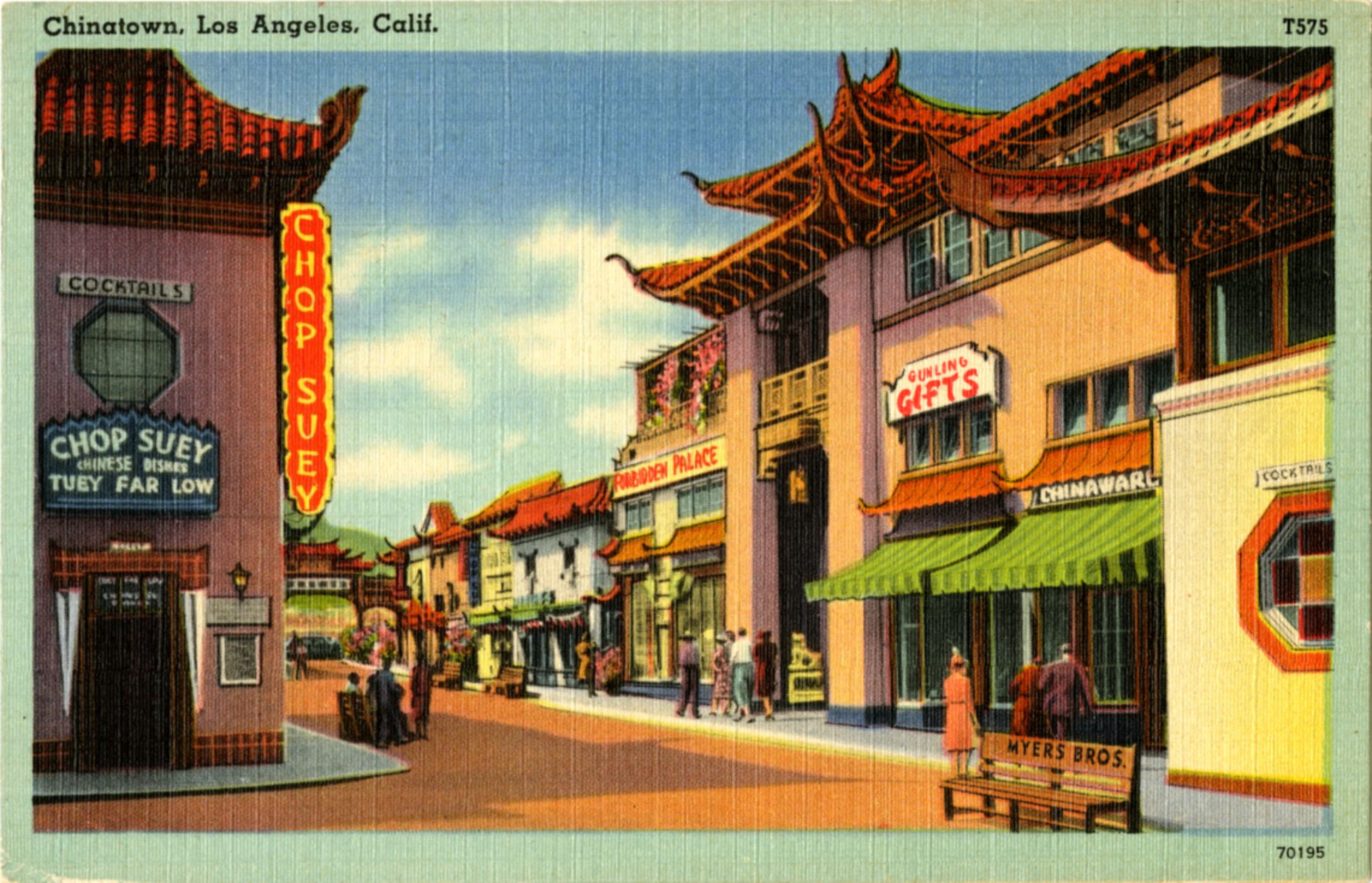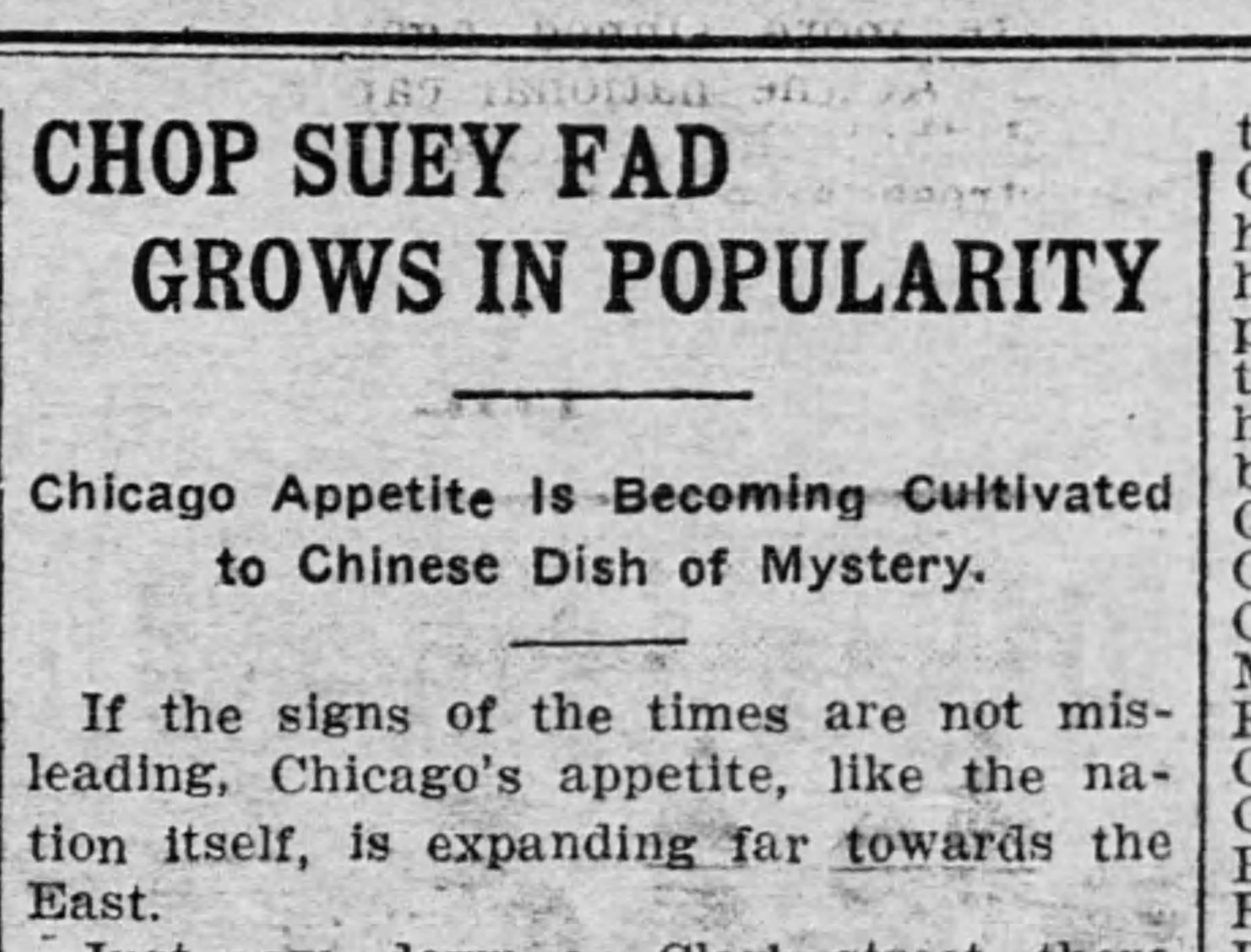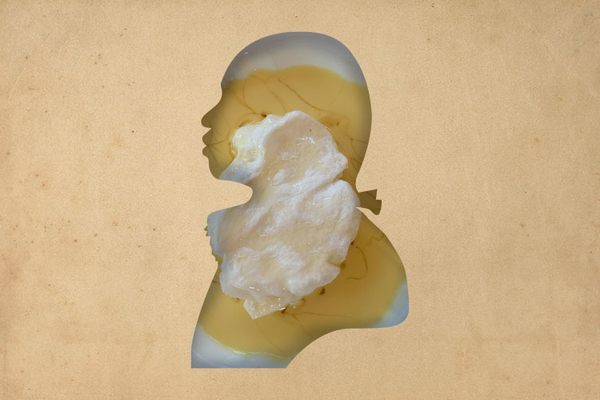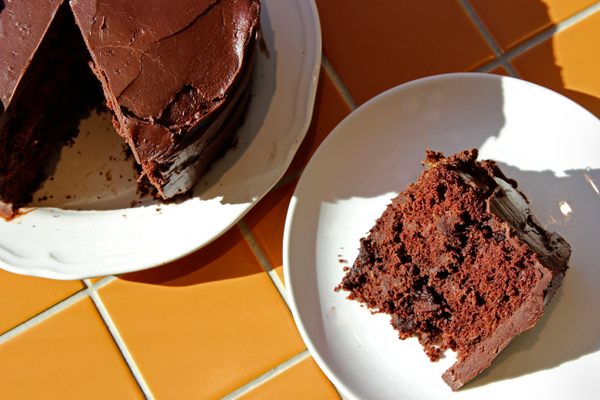

The Hidden, Magnificent History of Chop Suey
Discrimination and mistranslation have long obscured the dish’s true origins.
Sometime in the late 18th century, a wealthy salt merchant named Tong Yuejin decided to throw a banquet. The event took place in Tong’s luxurious quarters in Yangzhou, a metropolis 170 miles north of Shanghai. The meal was opulent, even by the standards of the city, whose inhabitants were notorious, as contemporaries quipped, for “throwing money around like dirt and dung.”
Tong’s dinner was a study in conspicuous consumption, with hundreds of dishes. For the occasion, he ordered his cooks to prepare some of the most scrumptious delicacies that money could buy, such as edible bird’s nest, shark fin soup, lake crab, sea cucumber, roast duck, and suckling pig. He also added chop suey. Today, we might think this humble dish was out of place on his table. But chop suey belonged there.
Most people in the English-speaking world know chop suey as a vintage Chinese American dish. For decades, scholars and foodies have heaped scorn on it. Historian Andrew Coe, author of Chop Suey: A Cultural History of Chinese Food in the United States, characterizes the dish as a “brownish, overcooked stew, strangely flavorless, with no redeeming qualities, and redolent of bad school cafeterias and dingy, failing Chinese restaurants.”
Coe is on the mark about many American incarnations of the dish. Nowadays, most chop suey ingredients come straight from a can. To prepare it, heat up a pan, add oil, meat slivers, and sauce-covered vegetables from a tin. Then pour in soy sauce and voilà, you have a quick weeknight meal composed of soggy bean sprouts, soft water chestnuts, and faded pink bell peppers.

But chop suey arrived in the United States in the mid-19th century to much acclaim. In 1886, journalist Allan Forman recalled a splendid meal taken in New York’s Mong Sing Wah, a place he called a “Celestial Delmonico’s”—a label that compared the Chinese restaurant favorably to the era’s leading fine-dining establishment. This writer also extolled “a toothsome stew composed of bean sprouts, chicken’s gizzards and livers, calf’s tripe, dragon fish, dried and imported from China, pork, chicken and various other ingredients which I was unable to make out.” That was chop suey.
At the start of the 20th century, this stew came to exemplify what historian Samuel C. King called the “Chinese epicurean sensibility” to the American ruling class. Chefs prepared it for high-brow club meetings, plays, and formal balls. Chop suey adorned tables at Chicago’s exclusive Victoria Hotel, while American socialites served the dish at parties in their upscale private residences.
Yet chop suey’s star soon began to fade. Chinese immigrants realized they could make a living selling chop suey and other Southern Chinese fare not just to America’s rich and powerful, but also to the working class. When statesman and revolutionary Liang Qichao visited New York City in 1903, he was shocked to find hundreds of eateries catering to what he called the American “addiction” to this one dish. Liang was underwhelmed with the quality of the Americanized rendition, to put it lightly. “As for what they call ‘chop suey,’” he fumed, “the cooking skills involved are so subpar that no one in China would ever eat it.”
Liang never said what exactly irked him about the dish. But cookbooks containing chop suey recipes published a few years later offer clues. The organ meats—previously the stew’s chief attraction—had begun to disappear from chop suey. According to Roger Horowitz, author of Putting Meat on the America Table: Taste, Technology, Transformation, the missing offal was a casualty of a broader change in the way that meat was distributed in the United States. The rise of cooling technology in the 1880s allowed large packing houses to centralize the processing of beef quarters and processed pork, which were shipped across the country in refrigerated train compartments. While this change made meat accessible to more Americans than ever before, it also meant that offal was harder to find at local butchers. After the 1890s, offal was increasingly reserved for sausage filling.
The worst, however, was yet to come. In the 192os, the founders of the Michigan-based La Choy Corporation discovered that they could make a fortune putting chop suey vegetables into a can. While this helped make the dish a household staple, it also tarnished chop suey’s reputation. By the 1960s, gourmands, restaurant critics, and Chinese food lovers all had snubbed the dish. Restaurateurs like the legendary Cecilia Chiang, who owned the Mandarin, one of the first fine-dining Chinese restaurants to gain a national following in the mid-20th century, refused to serve it.

Because of its ubiquity, all sorts of legends have popped up surrounding the true origins of chop suey. One holds that it was invented by Chinese cooks in California, who recycled kitchen scraps to feed hungry American gold miners. The same legend also asserts that chop suey means “odds and ends,” or even “garbage.” Others, by contrast, suggest a Chinese origin for chop suey, but insist that it was originally peasant grub from Toisan, a county in Guangdong, the main source of 19th-century Chinese immigrants in the United States.
Like most myths, the stories about the humble origins of chop suey fail to tell the whole truth. Toisan immigrants did introduce at least one version of the offal stew to America. But chop suey’s name did not originally connote leftovers. Instead, the English word is borrowed from the Toisanese tsaap slui (雜碎). As historian Yu Renqiu notes, the two characters represent a set phrase, referring to entrails and giblets, which were once the main ingredients of the dish.
It is not certain how these urban legends about chop suey being leftovers began. Perhaps it sprung from a jumbled translation, and remained uncorrected because few American food scholars could read old Chinese sources. Regardless of how it started, this view of chop suey as kitchen scraps became dominant in the United States for much of the 20th century. In fact, its staying power reflected the fact that until the 1960s, Americans regarded Chinese immigrants in a distinctly negative light: as poor, unlettered peasants. This view shaped their assessment of Chinese food. Most Americans were—and are—used to thinking about Chinese food just as quick, cheap eats as opposed to anything fancy. Even as Chinese people in the States faced violence and social exclusion, the American public undervalued and belittled their cuisine.

But chop suey was anything but garbage in China. The first attested usage of chop suey as the name of a dish surfaced in the late 16th century, in the famed folk novel Journey to the West, traditionally attributed to Wu Cheng’en, a writer from the Yangzhou area. After that, chop suey appeared frequently in Chinese cookbooks, including from other parts of China. The anonymous author of All Mutton Recipes, a Chinese cookbook written in the 18th or 19th century, instructed readers on the art of preparing chop suey from sheep organs either stewed in blood soup, steamed, or wok-fried. The author recommended topping the innards with green onions, pepper, parsley, and glazed lotus seeds.
Offal also appealed to the ethnic Manchu rulers of China, who founded the Qing dynasty (1644-1911). The Qianlong Emperor, who reigned from 1735 to 1796, made a regular habit of consuming innards: flash-fried, stewed, and pickled in rice beer. This point was not lost on Han Chinese merchants like Tong, whom contemporaries remembered as “a master schemer.” To ingratiate himself with the Manchu officials who controlled his access to the lucrative salt industry, Tong treated his guests to two different versions of chop suey at the lavish, multi-course meal that he threw at his Yangzhou residence. The first version was cooked in the Manchu fashion, showcasing sheep livers and intestines both boiled and braised. The second, presented in the Han Chinese style, was more similar to a modern stir-fry.
The practice of consuming chopped entrails on fancy occasions was not limited to places like Yangzhou, then a center of haute cuisine in China. Stews and sautés featuring organ meats also spread to the Pearl River Valley in China’s coastal south. Blessed with deep pockets and discriminating palates, Southern Chinese merchants also entertained officials lavishly. They too appreciated their bird and pork organs. One lauded version of chop suey—still on the menu at a venerable Cantonese chain in Taiwan—combines gizzards, pork strips, bean sprouts, and bamboo shoots to make a flavorful stir-fry. This version of chop suey, truer to its roots than the gloopy American variety, found its way into Taiwanese food personality Fu Pei Mei’s celebrated Pei Mei’s Chinese Cook Book, published in 1969. The standard chop suey “odds and ends” origins story also appeared with the recipe—but only in the footnotes of the English-language translation.
The true story of how chop suey ended up in the United States is much more straightforward than legend would have it. Chop suey trailed Southern Chinese merchants to California. Like Tong, mid-19th century entrepreneurs saw good food both as a source of personal pleasure and financial success. As early as the 1860s, many began entertaining American politicians several times a year. Those banquets, documented in the English-language press, took place in elegant halls that would have rivaled Tong’s Yangzhou residence. In 1892, an American journalist described Hong Fer Low, an eatery in San Francisco, as “most gorgeously fitted up, the walls being made of carved woods imported from China and inlaid in places with precious stones.” The chandeliers in that establishment cost $1,500 a piece, the equivalent of $50,000 today.

Like Tong, these newcomers to America also spent exorbitant sums of money on food in the hopes of winning over local officials. Their banquets became famous for the lineup of what one journalist called “Oriental dainties.” Some banquets even came close to Tong’s in terms of their scale: at one dinner held in San Francisco in 1865, the host served 325 courses. Surviving menus also disclose the same combination of banquet staples that Tong’s cook had prepared a century before: bird’s nest and shark fin soup, roast duck, and chop suey. The merchants must have been surprised that it was the chop suey, rather than the pricier bird’s nest, that impressed their American guests.
While it long ago lost its luster in the United States, chop suey remains a beloved food in northwestern China. Cooks still fry or braise the finely sliced lungs, hearts, and intestines of sheep together with juicy mutton strips, finishing the dish with parsley, pepper, and scallions. These days, it also incorporates some ingredients from the Americas, such as julienned potatoes and chili oil. In Shaanxi, home to China’s famous terracotta warriors, chop suey even maintains its status as haute cuisine. The local government has declared it “Intangible Cultural Heritage,” and local food writers have noted that formal functions often still feature the dish.
If you are wondering whether gourmet chop suey will appear on menus in America anytime soon, don’t hold your breath. Thanks to the pioneering efforts of restaurateurs like Cecilia Chiang and Ken Hom, Americans have become more appreciative of China’s diverse traditions of fine dining. But they have yet to overcome their aversion to chop suey’s main ingredient, the organ meat. There are, however, signs of change on the horizon. In recent years, environmentally conscious chefs have championed nose-to-tail eating. In this way, they have begun paving the way for liver and brain to return to the standard American plate after a more-than-century hiatus.
Regardless of whether chop suey will get a second act in the United States, the time has come to set the record straight about this storied stew. In both China and the United States, chop suey has always had an illustrious pedigree.

Qing-Dynasty Chop Suey
Ingredients
- ½ lb lamb shoulder, in one piece
- One lamb heart, approximately ½ lb
- ¼ cup ginger, sliced into thin slivers
- ¼ cup scallion whites
- 2 pieces star anise
- 1 bunch parsley, cleaned and trimmed
- ½ teaspoon salt (plus more to taste)
- Black pepper (to taste)
- 2 tablespoons vegetable oil
- 3 cups beef or chicken stock
Instructions
-
Clean and cut the lamb shoulder into thin strips.
-
Wash the lamb heart, removing the fatty tissue on the outside and on the top. Carefully remove the tendons on the inside and slice the heart into thin, flat strips.
-
Heat a medium pot of water, and when the water boils, add the shoulder and heart. Allow the water to return to a low boil, then turn down the heat and let the water simmer for about four minutes. Remove the scum from the top of the liquid, then strain the pot and set the meat aside.
-
Heat up a pan or wok with oil, then add the ginger. Sauté on high heat until fragrant, then add the star anise, scallions, lamb shoulder, and heart, stirring until the meat is browned.
- Add the stock to the pan along with the salt. Wait for the liquid to reach a low boil, then turn down the heat and sprinkle in the parsley. Simmer for an hour, or until the meat is tender. Season with more salt and pepper to taste.
Notes and Tips
This is my interpretation of a Qing Dynasty (1644-1911) recipe for chop suey made with sheep organs. People still make it today, but many add chili oil, which lends the stew a glorious pink color.
To find organ meats, you’ll need to call an organic or halal butcher. They are likely to have lamb heart for special orders. It is harder to find intestines, and impossible to purchase lungs in the United States (the latter has been illegal to sell since 1971). For this reason, I have substituted lamb shoulder for the lungs. Lamb shoulder is sometimes used in American versions of haggis, as a replacement for lung.
Gastro Obscura covers the world’s most wondrous food and drink.
Sign up for our regular newsletter.































Follow us on Twitter to get the latest on the world's hidden wonders.
Like us on Facebook to get the latest on the world's hidden wonders.
Follow us on Twitter Like us on Facebook